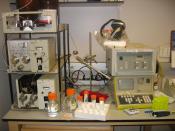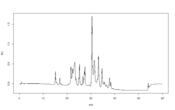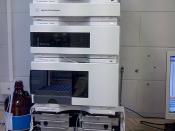Aim To investigate the possibility of determining log P via Reversed-Phase LC
Introduction
Increasingly, the determination of low concentrations of active ingredients in complex mixtures, sold for human consumption, has become more necessary. Regulations have imposed strict limits on the type and concentrations of a host of substances sold as foods or drugs. Such requirements demand analytical techniques that are fast and reliable and combine the separation and analysis steps in a single operation. Chromatography is the most widely used technique for the analysis of non-inorganic mixtures. Gas chromatography (where the sample must be volatilized) and liquid chromatography (where the sample can be determined in the liquid state) are the most common methods in general use. High Performance Liquid Chromatography (HPLC) is the method of choice whenever the sample cannot easily be converted to the gas phase
Theory
The figure above depicts the main components of a modern HPLC system.
In HPLC, a solution containing the compounds of interest is injected into a loop which has been calibrated to contain a specified volume. The valve switch is then rotated, allowing a sample stream of mobile phase (eluent) to sweep the sample from the loop onto a column, packed with a suitable stationary phase, where the separation occurs. The eluent is delivered from a pump at a constant rate, at a pressure sufficiently high to overcome the backpressure of the column. The separation efficiency is inversely proportional to the particle size of the column packing material. High pressures are required to force a liquid through a tightly-packed column filled with small particle material, and the availability of high pressure solvent delivery systems is directly responsible for the "high performance". Assuming that a suitable column has been chosen for the separation of interest, all components should pass through the column and "elute"...


